LEAPS-INNOV kicks off!
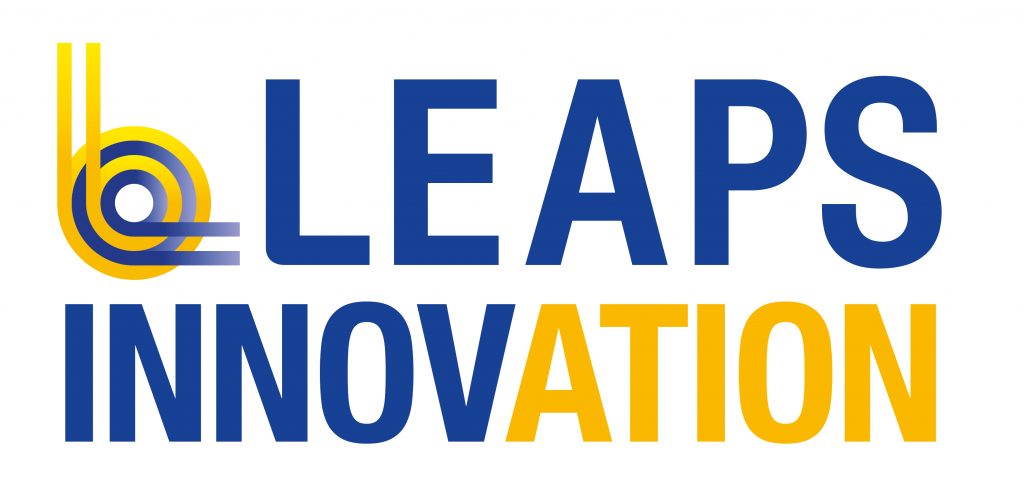
LEAPS is delighted to announce the LEAPS-INNOV kick-off meeting taking place on 20-21 April 2021 (fully digital, upon invitation only).
In the context of open innovation, the LEAPS-INNOV pilot project focuses on the implementation of new strategies and activities for long-term partnerships between industry and the European light sources, synchrotrons and free-electron lasers, with their tens of thousands of users.
LEAPS-INNOV aims to kick-start the implementation of the LEAPS Technology Roadmap and, at the same time, to foster a partnership with European industry through open innovation by offering joint technological developments and advanced research capabilities with LEAPS members for industry as collaborator, supplier and user.
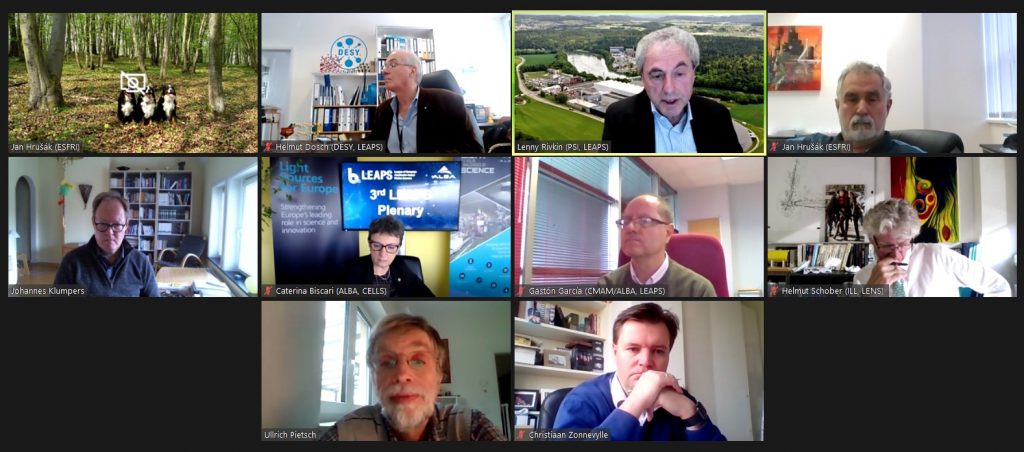
3rd LEAPS Plenary – 2020
The LEAPS Plenary meeting 2020 was a fully online event. Read more about it here: https://leaps-initiative.eu/leaps-plenary-2020/
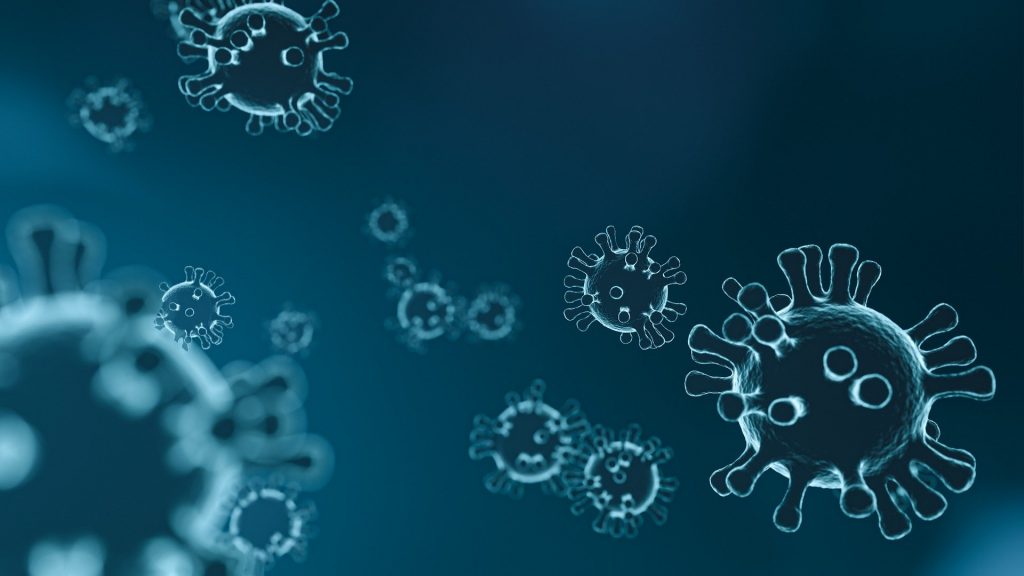
‘Learning to run again’
– a webinar on the challenges for synchrotrons and FELs to restore effective operations during the COVID-19 pandemic
Research Infrastructures such as synchrotrons and Free Electron Lasers (FELs) play a crucial role in enabling some of the most significant fundamental scientific and societal challenges of our time to be tackled, and none more so challenging just now than mounting an effective and enduring response to the COVID-19 pandemic. While much human activity stopped as COVID-19 swept across the world, many facilities developed ways to continue to run to support critical research on the Coronavirus, and have provided critical new insights into the structure and function of the virus, and ways to inhibit infection pathways.
The operations of synchrotrons and FELs will have to adapt to the constraints of working in a post-COVID-19 world for some time to come. LEAPS organised a webinar on 15 June with approx 120 participants to explore some of the challenges of restoring the fullest possible level of operations for its tens of thousands of users in universities and industry. It focused on three areas: minimising risks to the safety of staff and users; development of a wider range of services for remote users; effective engagement with a user community that may be less free to travel for some considerable time to come. The summary of the webinar can be downloaded from the link below.
2nd LEAPS Plenary – 2019
The health, prosperity, and security of European citizens today and in the future depend on meeting increasingly demanding challenges. These can be found in energy and transport, healthcare and food safety, and sustainable living and all must be tackled within a thriving, inclusive and green economy. This demands new technology, new treatments and a better understanding of the world around us, all of which point to an increased role and reliance on highly sophisticated analytical tools like accelerator-based light sources. With the methods and techniques available at the LEAPS member facilities, researchers from European academia and industry are provided with the most incisive means of measuring and unravelling atomic and molecular structures of the world around us. The information and knowledge revealed at this scale can have a transformational effect on science and technology and thus on the future of our society.
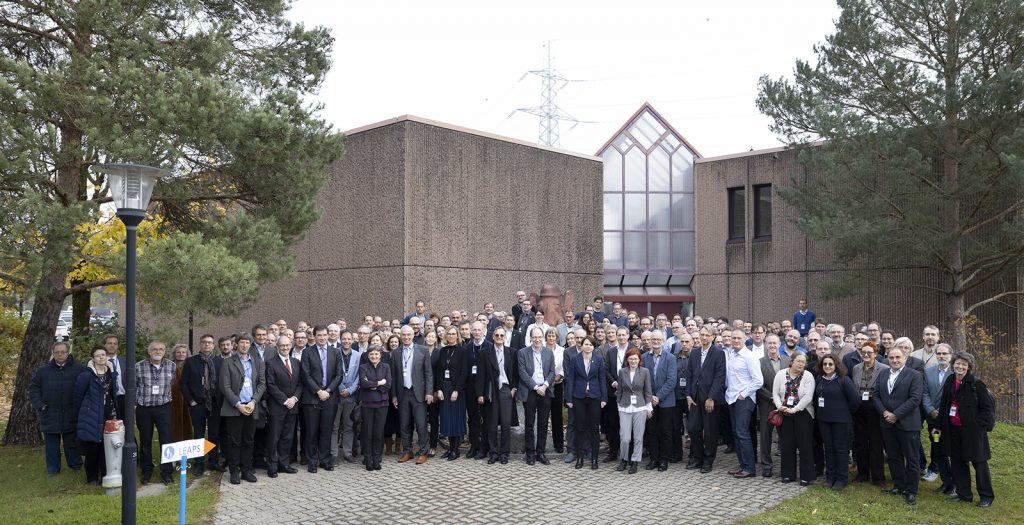
This was the starting point of the second LEAPS Plenary meeting, held at Paul Scherrer Institut in Villigen, Switzerland on 18–19 November, 2019. More than 180 participants from around Europe met up to discuss how the LEAPS Programme should be developed to best meet the needs and expectations from scientists using the facilities, from the funders and society at large.
The first day of the Plenary started with a welcome to PSI by Leonid Rivkin, PSI vice director. It continued with an update on the LEAPS status by Ute Krell, DESY, the ExPaNDs status by Mark Heron, Diamond Light Source and the PaNOSC status by Andy Goetz, ESRF.
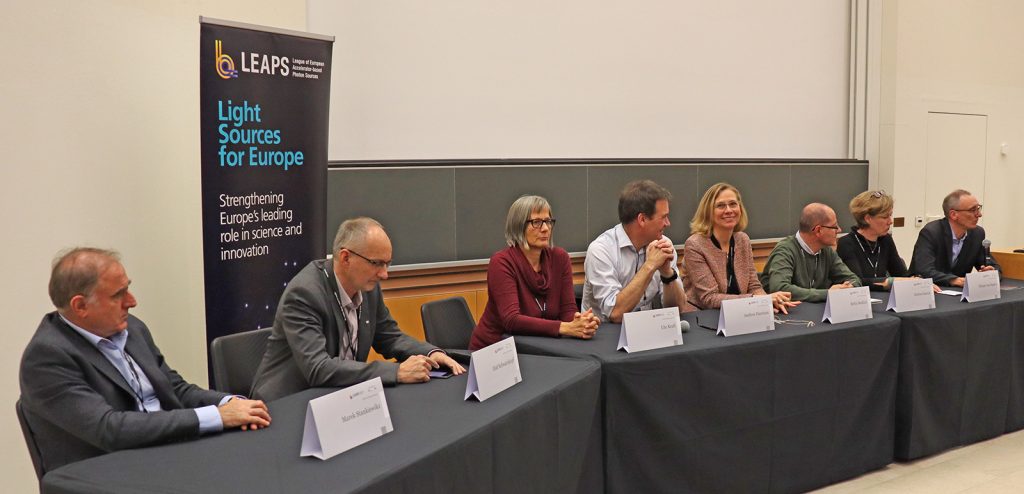
Mirjam van Daalen, PSI chaired the first session, and it was summed up in a panel discussion lead by Jean Daillant, Soleil.
The afternoon was devoted to meetings between the different workgroups and strategy groups within LEAPS to discuss future steps, e.g. LEAPS addressing clusters and missions in Horizon Europe, the roadmap process and smart specialisation. All of which was presented by the group leaders in plenum during the early evening, guided and summed up by Gaston Garcia, ALBA.
The second day, when guests and representatives from national funding agencies and ministries joined the Plenary meeting, started with Thierry Strässle, PSI greeting the participants welcome and giving a short overview of the facility. Following this, Helmut Dosch, DESY and Caterina Biscari, ALBA – chair and vice-chair of LEAPS – gave an update on the LEAPS status and outlook to set the stage for the newly arrived.
An essential topic of the day was to explore how to make the most of the national funding by adding funding from Horizon Europe. LEAPS is clearly anchored in Horizon Europe’s Pillar 1, Excellent Science, but also opens up opportunities for so-called co-creation with Pillar 2, Global Challenges. In addition, LEAPS meet the transversal goal in Horizon Europe, Widening Participation and Strengthening the European Research Area, very well through the educational, training and outreach activities done as well as by granting free access to the facilities based on scientific excellence no matter from which country the research group comes.
LEAPS is currently negotiating a funding scheme with the European Commission, and the ambition is clear: LEAPS should be given the status of a European Partnership within Horizon Europe. However, as Helmut Dosch and Caterina Biscari declared in their opening statements; “LEAPS recognise an inherent added value in this new pan-European cooperation, independent of funds from Brussels. By showing that we have a strong will and ambition to cooperate by implementing joined projects, we will get a powerful voice and a visible place in Europe.”
The plenary session that followed, chaired by Andrew Harrison, Diamond Light Source, began with a presentation on Horizon Europe by Adam Tyson, Head of Unit, Research & Industrial Infrastructures, European Commission. Adam pointed out that it is a moment of change within the EC. Not only by having a new President-elect, new Commissioners, new portfolios and policies, but also change in terms of identifying new challenges and new ways of working.
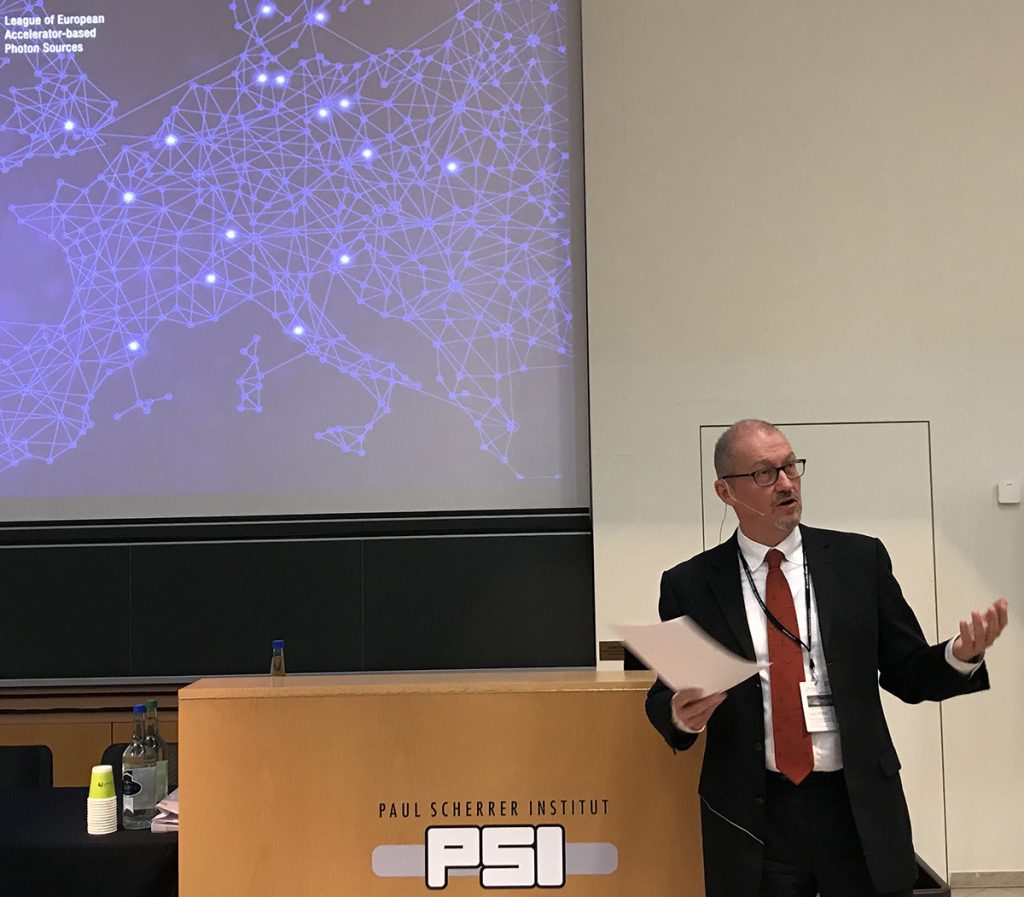
He continued by saying “the new vision and priorities set out by President-elect Ursula von der Leyen are all issues where research and innovation have a strong role to play. It is a fantastic opportunity but also a very big responsibility for all stakeholders in the field.”
The implication for national research infrastructures and organisations like LEAPS is that the national strategies need to be aligned with the European strategy to maximise the impact on global challenges. It also means Adam Tyson explained, that collaboration is necessary not only between research facilities of the same sort, such as LEAPS but also with other types of research facilities and consortiums to be able to provide fully integrated services to the researchers. This is how problems are solved through a more significant integrated approach.
Adam Tyson concluded his talk by saying “LEAPS has to be one of those partners, on the European level, that helps us think about the way we interact in the future. And the best way you can do that is by being integrated with other networks across different disciplines focusing on the contribution to solving the challenges that Europe and the world face in the twenty-first century.”
As on cue, the next speaker was Christian Ruegg from PSI representing LENS, League of European Neutron Sources, who gave an update on their status and following him was Rolf Heuer, Chair of SESAME, who showed the progress of the international synchrotron facility in Jordan.
The theme for this second LEAPS Plenary meeting was “LEAPS benefits all of Europe” and to give a broad view on this topic, a panel discussion lead by Andrew Harrison, DLS, was held. Participating in this was Mirjam van Daalen LEAPS/PSI, Diego Casadei, CosyLab, Michael Hennig, LeadXPro, Edward Mitchell, LEAPS/ESRF, Marco Stampanoni, PSI/GratXray AG, Francine Solal, CNRS, France and Kirsi Lorentz, The Cyprus Institute, Cyprus.
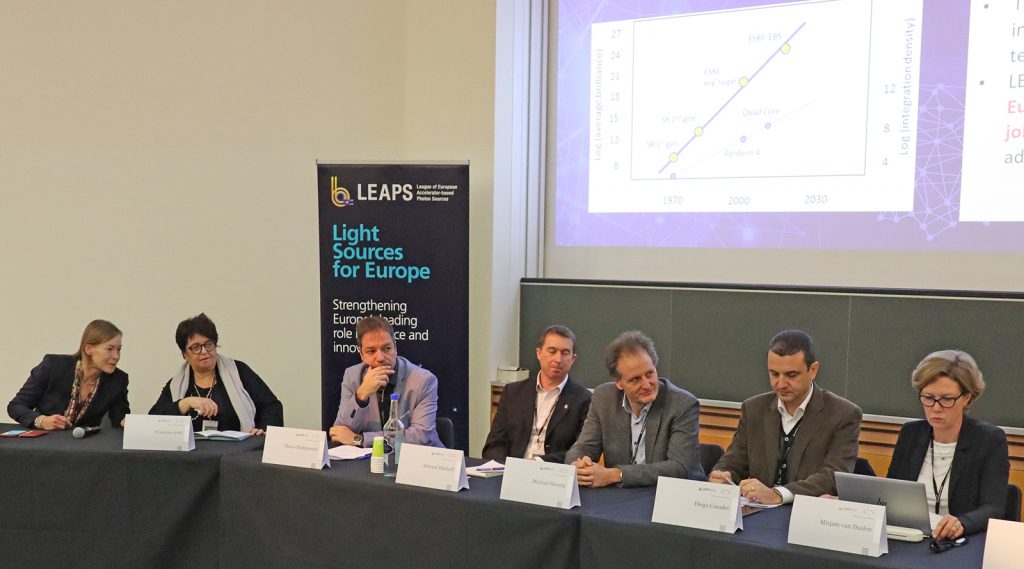
The conclusion drawn was that research facilities need to engage with users both from industry and academy to make the most of the investments already done and to have firm and long-term support from national funding agencies and ministries to be able to stay world-leading and produce excellent science.
With these presentations as a background, the workshop session of day two started aiming to clarify how industry and European member states can contribute to and benefit from LEAPS in the context of the strategy of Horizon Europe, as described out by Adam Tyson. But also, to explore the possibilities for even further cooperation with universities and research centres. All with the purpose to integrate existing and new user communities in not only the use but also the development of research facilities. The result of these workshops was presented in the last session, chaired by Britta Redlich, FELIX, and will be used as input for the continued work that will lead to a comprehensive LEAPS Programme, benefitting all of Europe.
The second LEAPS Plenary meeting then went on with a presentation by Gaston Garcia, ALBA, on achievements and future plans of LEAPS Landscape Analysis. Klaus Attenkofer, ALBA, presented the upcoming LEAPS meets Quantum Technology Conference in May 2020, and finally, conclusions and next steps were summed up by Helmut Dosch and Caterina Biscari.
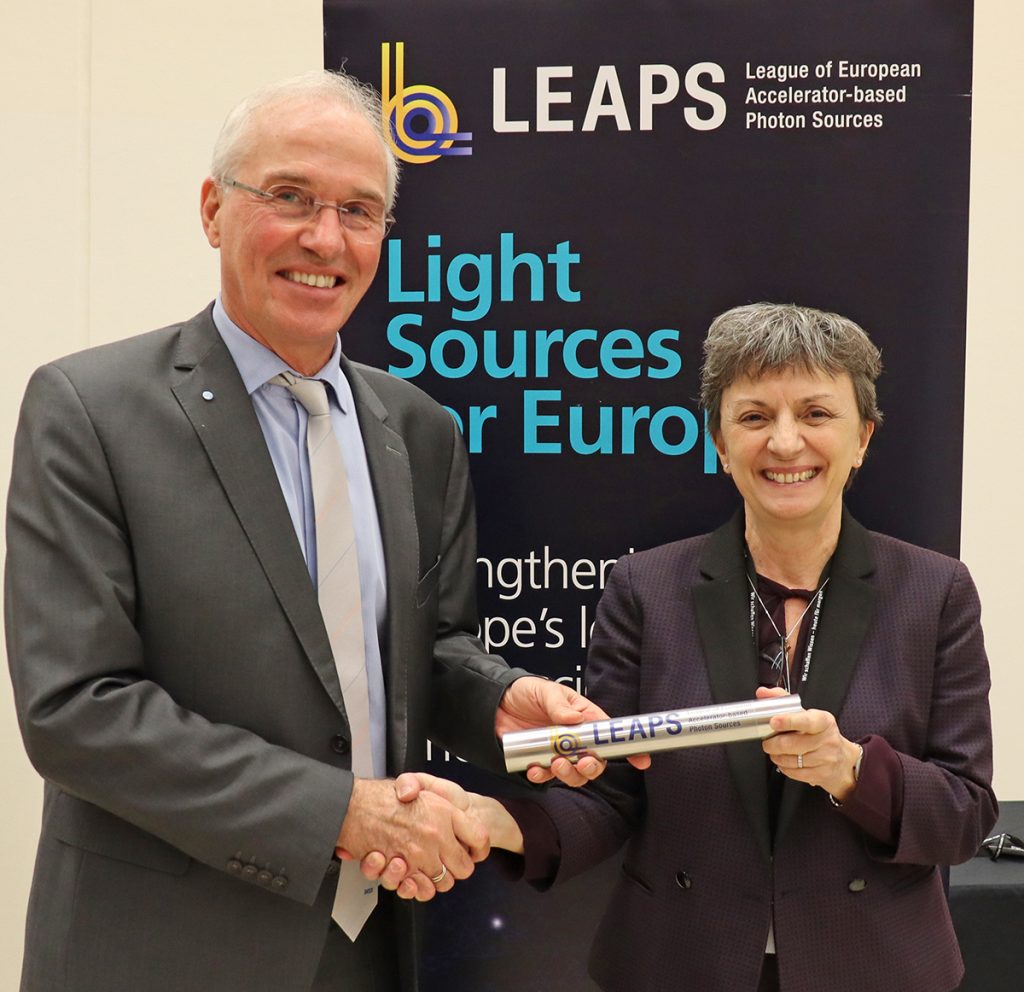
Caterina Biscari will take over as Chair of LEAPS in January, and Helmut Dosch took the opportunity to hand over the symbolic baton of LEAPS during the Plenary meeting and wishing her good luck in the future work. He also thanked all participants for having had the opportunity to lead the accelerator-based European photon sources in their endeavour to shape a world where European science is a catalyst for solving global challenges, a key driver for competitiveness and a compelling force for closer integration and peace through scientific collaboration.
